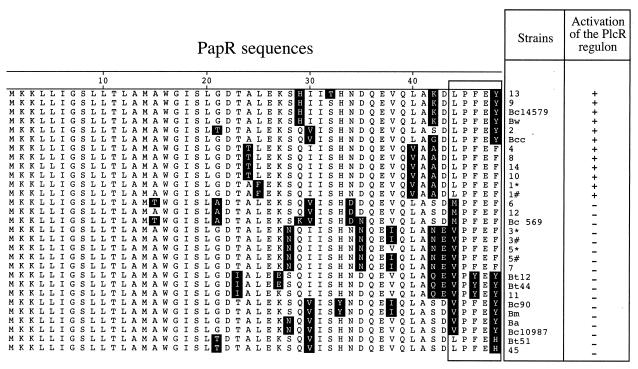FIG. 2.
Comparison of the PapR peptide sequences of various B. weihenstephanensis, B. thuringiensis, B. mycoides, B. cereus, and B. anthracis strains. Numbers 2, 4, 6, 7, 8, 9, 10, 11, 12, 13, 14, and 45 refer to the serotypes of the B. thuringiensis strains as defined by Lecadet and colleagues (14). The type strains of these serotypes were used in this study. 1* and 1#, B. thuringiensis serotype 1 strain 407 Cry− and strain Berliner 1715, respectively; 3* and 3#, B. thuringiensis serotype 3 strains kurstaki HD1 and kurstaki KT0, respectively; 5* and 5#, B. thuringiensis serotype 5 serovars canadensis and galleriae, respectively; Bc14579, B. cereus ATCC 14579; Bc10987, B. cereus ATCC 10987; Bw, B. weihenstephanensis (type strain); Bcc and Bc90, B. cereus environmental strains; Bc 569, B. cereus strain 569; Bt12, Bt44, and Bt51, B. thuringiensis environmental strains; Bm, B. mycoides; Ba, B. anthracis strain Ames. The sequences of PlcR-PapR from B. anthracis and from B. cereus strains ATCC 14579, ATCC 10987, and 569 were determined from published data (9, 20, 22, 23). PlcR-PapR sequences from B. thuringiensis serotypes 1, 2, 3 (kurstaki KT0), 4, 5 (serovar galleriae), 6, 7, 8, 9, 10, 11, 12, 13, 14, and 45 have been described previously, as well as PapR from B. mycoides (25, 26). The other PlcR-PapR sequences were determined in this study, as indicated in the text. The symbol “+” indicates that the strain was able to activate the PlcR regulon in the reporter strain B. thuringiensis 407 Cry− (plcA′-lacZ) ΔpapR, as described in the legend to Fig. 1. The symbol “-” indicates that the strain was unable to activate the PlcR regulon.

